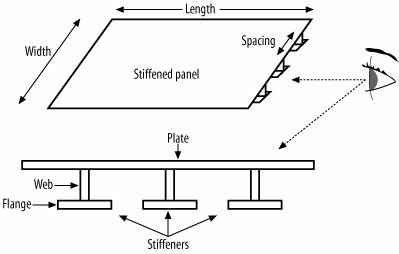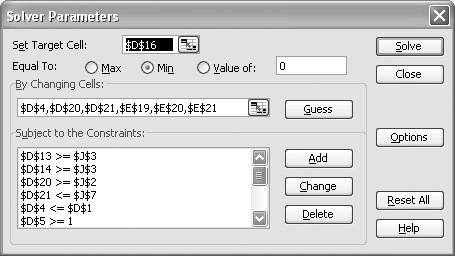Optimizing Engineering Design Problems
Problem
You're working on an engineering design problem and would like to see how you can leverage Excel to find an optimum design solution.
Solution
Model your design problem in Excel as an optimization problem and then use Solver to find a solution.
Discussion
It is rather straightforward to model many different engineering design problems in Excel. Many engineers do so on a daily basis. Moreover, once you have a model set up in Excel, it's a small step to use Solver to optimize that model. Take a look at the spreadsheet in Figure 13-12.
Figure 13-12. Engineering design optimization example

This spreadsheet represents a typical structural engineering design task. I don't want to go too far describing all the structural engineering background relevant to this problem; but I'll give you an overview so you can get the gist of what we're trying to optimize. Basically, this is a model of a stiffened panel. A stiffened panel is comprised of a plate with beams attached to it to provide strength and rigidity. In this case, the panel is comprised of an aluminum plate, 150 cm long and 100 cm wide, supported all around its edges. The plate also has attached to it a number of T-type stiffeners. Figure 13-13 illustrates this sort of panel.
Figure 13-13. Stiffened panel

You can imagine such a panel forming a portion of a wall of an aluminum building or perhaps the hull of an aluminum boat. The latter case is actually the inspiration for this example.
Boats, especially high-speed boats, are sensitive to weight in terms of performance. So a common task facing naval engineers involves sizing panels like this one so that it has enough strength but is also as light as possible. Sure, you could be conservative and use a really thick plate with a lot of stiffening beams, but that would be expensive and heavy.
You have to use some sort of standard criteria to determine whether such a panel is strong enough. There are such codes (as in rules and regulations, not to be confused with software code) for many types of structures and in this particular case, you can use the standard codes applicable to aluminum boats. These codes require engineers to calculate certain properties of the panel to compare with acceptable values given in the codes. The spreadsheet shown in Figure 13-12 performs just this sort of calculation and comparison.
Cells D1 through D8 contain basic information on the panel and associated stiffeners. The table toward the bottom, cells C18 through J22, contains more specific information on the geometry of the components making up the stiffened panel. This panel also performs the required engineering calculations needed to determine the properties of the stiffened panel. The results of these calculations are contained in cells D10 through D14.
Finally, cells J1 through J7 contain code-related requirements on the properties of the stiffened panel. These cells also contain some practical engineering limits.
The optimization task is to find an optimum combination of plate thickness, stiffener web size, stiffener flange size, and spacing between stiffeners that will yield a panel meeting the code requirements, while at the same time resulting in the minimum achievable weight. Therefore, in terms of optimization, minimizing weight is the objective. All the other requirements become constraints.
Since the material is homogeneous and uniform in this case, we can minimize weight by minimizing the total volume of metal material used to build the stiffeners and panel. The volume is computed by summing the volumes of the plate and stiffeners. Cell D16 contains the volume calculation, and you can see the formula in the formula bar in Figure 13-12. This is our objective function.
The variables we want to change include the stiffener spacing, plate thickness, stiffener web depth and thickness, and stiffener flange width and thickness.
Figure 13-14 shows the Solver model I set up for this problem.
Figure 13-14. Design optimization Solver model

As expected, cell D16, the objective function, is the target cell, which is set to be minimized. The By Changing Cells textbox includes all of the shaded cells in Figure 13-12 corresponding to the variables we want to vary, as discussed a moment ago.
All the code and design requirements discussed earlier become constraints. (See Chapter 9 for more on setting up Solver models and adding constraints.) For example, the section modulus (SM) of the stiffened panel (SM top and SM bot in the spreadsheet) must be greater than or equal to the Min. allowable SM specified in cell J3. The corresponding Solver constraints are $D$13 >= $J$3 and $D$14 >= $J$3, as shown in Figure 13-14. I added similar constraints for each design requirement listed in cells J1 through J7.
Running Solver resulted in the optimum values shown earlier in Figure 13-12. Initially, I tried 50 cm for stiffener spacing and 1 cm for all other optimization variables. Solver readily found a solution with this initial guess. Just to be sure, I tried several other initial guesses; Solver converged on the same solution, so I'm fairly confident that this solution represents a global optimum in this particular design space.
In summary: if you can model a design problem in Excel, you can optimize it in Excel. The trick is in identifying your objective function and the variables you want to change. For highly nonlinear problems, you also have to be careful that you don't converge to a local minimum. You can use the technique I showed you in Recipe 13.4 to mitigate the risk of not finding a global optimum.
Using Excel
- Introduction
- Navigating the Interface
- Entering Data
- Setting Cell Data Types
- Selecting More Than a Single Cell
- Entering Formulas
- Exploring the R1C1 Cell Reference Style
- Referring to More Than a Single Cell
- Understanding Operator Precedence
- Using Exponents in Formulas
- Exploring Functions
- Formatting Your Spreadsheets
- Defining Custom Format Styles
- Leveraging Copy, Cut, Paste, and Paste Special
- Using Cell Names (Like Programming Variables)
- Validating Data
- Taking Advantage of Macros
- Adding Comments and Equation Notes
- Getting Help
Getting Acquainted with Visual Basic for Applications
- Introduction
- Navigating the VBA Editor
- Writing Functions and Subroutines
- Working with Data Types
- Defining Variables
- Defining Constants
- Using Arrays
- Commenting Code
- Spanning Long Statements over Multiple Lines
- Using Conditional Statements
- Using Loops
- Debugging VBA Code
- Exploring VBAs Built-in Functions
- Exploring Excel Objects
- Creating Your Own Objects in VBA
- VBA Help
Collecting and Cleaning Up Data
- Introduction
- Importing Data from Text Files
- Importing Data from Delimited Text Files
- Importing Data Using Drag-and-Drop
- Importing Data from Access Databases
- Importing Data from Web Pages
- Parsing Data
- Removing Weird Characters from Imported Text
- Converting Units
- Sorting Data
- Filtering Data
- Looking Up Values in Tables
- Retrieving Data from XML Files
Charting
- Introduction
- Creating Simple Charts
- Exploring Chart Styles
- Formatting Charts
- Customizing Chart Axes
- Setting Log or Semilog Scales
- Using Multiple Axes
- Changing the Type of an Existing Chart
- Combining Chart Types
- Building 3D Surface Plots
- Preparing Contour Plots
- Annotating Charts
- Saving Custom Chart Types
- Copying Charts to Word
- Recipe 4-14. Displaying Error Bars
Statistical Analysis
- Introduction
- Computing Summary Statistics
- Plotting Frequency Distributions
- Calculating Confidence Intervals
- Correlating Data
- Ranking and Percentiles
- Performing Statistical Tests
- Conducting ANOVA
- Generating Random Numbers
- Sampling Data
Time Series Analysis
- Introduction
- Plotting Time Series Data
- Adding Trendlines
- Computing Moving Averages
- Smoothing Data Using Weighted Averages
- Centering Data
- Detrending a Time Series
- Estimating Seasonal Indices
- Deseasonalization of a Time Series
- Forecasting
- Applying Discrete Fourier Transforms
Mathematical Functions
- Introduction
- Using Summation Functions
- Delving into Division
- Mastering Multiplication
- Exploring Exponential and Logarithmic Functions
- Using Trigonometry Functions
- Seeing Signs
- Getting to the Root of Things
- Rounding and Truncating Numbers
- Converting Between Number Systems
- Manipulating Matrices
- Building Support for Vectors
- Using Spreadsheet Functions in VBA Code
- Dealing with Complex Numbers
Curve Fitting and Regression
- Introduction
- Performing Linear Curve Fitting Using Excel Charts
- Constructing Your Own Linear Fit Using Spreadsheet Functions
- Using a Single Spreadsheet Function for Linear Curve Fitting
- Performing Multiple Linear Regression
- Generating Nonlinear Curve Fits Using Excel Charts
- Fitting Nonlinear Curves Using Solver
- Assessing Goodness of Fit
- Computing Confidence Intervals
Solving Equations
- Introduction
- Finding Roots Graphically
- Solving Nonlinear Equations Iteratively
- Automating Tedious Problems with VBA
- Solving Linear Systems
- Tackling Nonlinear Systems of Equations
- Using Classical Methods for Solving Equations
Numerical Integration and Differentiation
- Introduction
- Integrating a Definite Integral
- Implementing the Trapezoidal Rule in VBA
- Computing the Center of an Area Using Numerical Integration
- Calculating the Second Moment of an Area
- Dealing with Double Integrals
- Numerical Differentiation
Solving Ordinary Differential Equations
- Introduction
- Solving First-Order Initial Value Problems
- Applying the Runge-Kutta Method to Second-Order Initial Value Problems
- Tackling Coupled Equations
- Shooting Boundary Value Problems
Solving Partial Differential Equations
- Introduction
- Leveraging Excel to Directly Solve Finite Difference Equations
- Recruiting Solver to Iteratively Solve Finite Difference Equations
- Solving Initial Value Problems
- Using Excel to Help Solve Problems Formulated Using the Finite Element Method
Performing Optimization Analyses in Excel
- Introduction
- Using Excel for Traditional Linear Programming
- Exploring Resource Allocation Optimization Problems
- Getting More Realistic Results with Integer Constraints
- Tackling Troublesome Problems
- Optimizing Engineering Design Problems
- Understanding Solver Reports
- Programming a Genetic Algorithm for Optimization
Introduction to Financial Calculations
- Introduction
- Computing Present Value
- Calculating Future Value
- Figuring Out Required Rate of Return
- Doubling Your Money
- Determining Monthly Payments
- Considering Cash Flow Alternatives
- Achieving a Certain Future Value
- Assessing Net Present Worth
- Estimating Rate of Return
- Solving Inverse Problems
- Figuring a Break-Even Point
Index
EAN: 2147483647
Pages: 206
